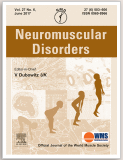 SEPN1-related myopathy (SEPN1-RM) is characterized by predominant axial muscle weakness, early scoliosis, rigid spine and severe respiratory insufficiency. The aim of the study was to characterize the mechanisms of respiratory dysfunction in SEPN1-RM patients.
SEPN1-related myopathy (SEPN1-RM) is characterized by predominant axial muscle weakness, early scoliosis, rigid spine and severe respiratory insufficiency. The aim of the study was to characterize the mechanisms of respiratory dysfunction in SEPN1-RM patients.
Breathing pattern and respiratory muscle strength were measured by means of esophageal (Pes) and gastric (Pgas) pressures. Seven patients aged 7-55 years (1 adult) at first respiratory muscle test were studied. Five patients were treated by nocturnal noninvasive ventilation (NIV) ≥ 4 months. Mean ΔPes was within normality during tidal breathing, but the ΔPgas/ΔPes index indicated an increased contribution of the rib cage and expiratory muscles, as compared to the diaphragm, in the pediatric patients and bilateral diaphragmatic paralysis in the adult patient. Forced vital capacity (FVC) was reduced in all patients (52 ± 19%pr) with mean FVC seated-supine drop of 24 ± 7%. Global inspiratory muscle and diaphragmatic strengths were moderately reduced in 2 patients, highly reduced in 4 patients and severely reduced in the adult patient. Expiratory muscle strength was moderately reduced in 6 patients and severely reduced in the adult patient. FVC and respiratory muscle strength remained stable in 2 patients treated by nocturnal NIV within a 3-year follow-up.
This study confirms that diaphragmatic dysfunction is a characteristic feature of SEPN1-RM and NIV may stabilize the decline in respiratory muscle strength.
